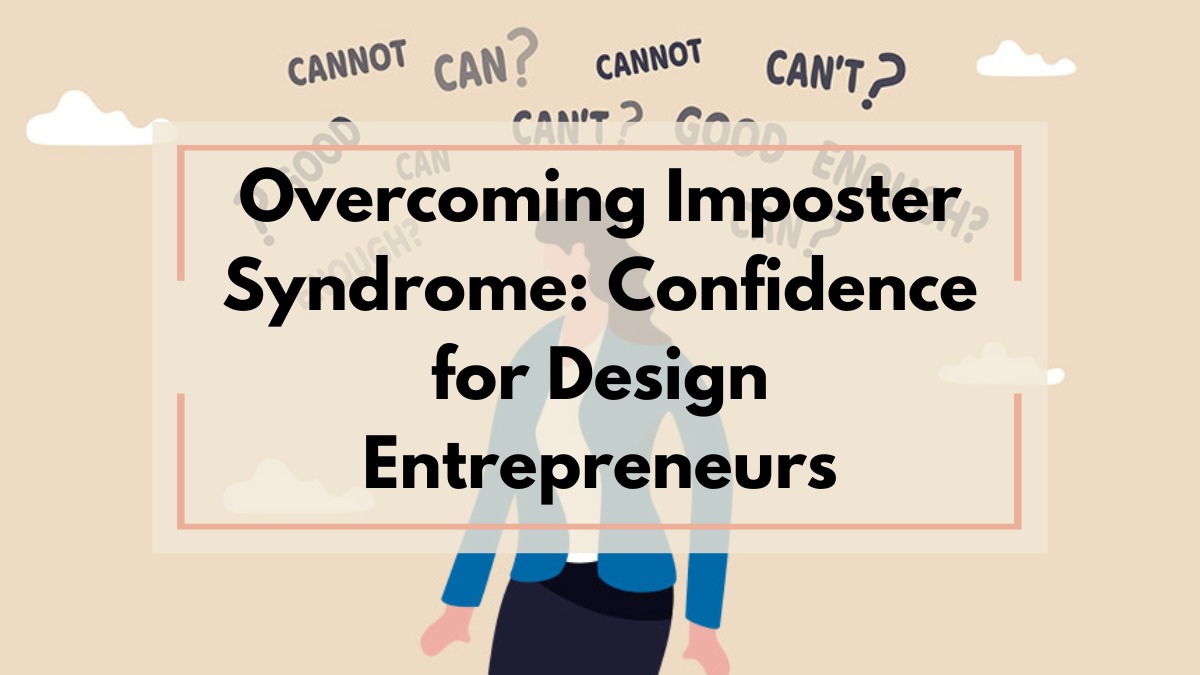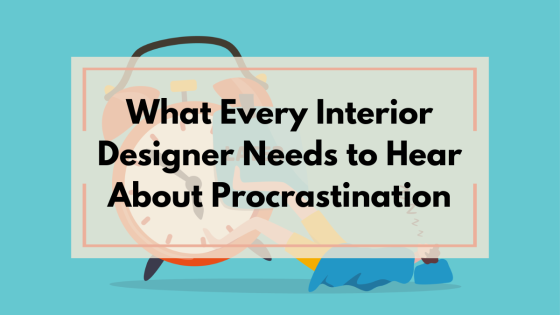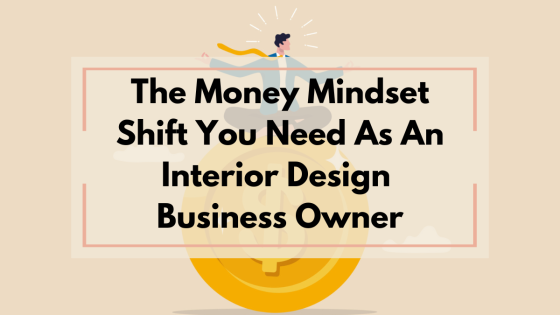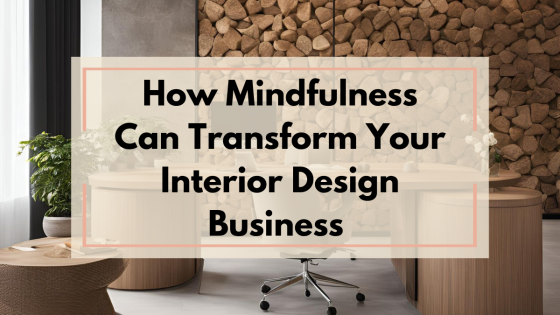Overcoming Imposter Syndrome: Confidence for Design Entrepreneurs

You've spent years honing your eye for design, building a portfolio that makes clients swoon, and establishing a business that consistently pays the bills. By all external measures, you're successful. So why does that little voice in your head keep whispering, "You don't actually know what you're doing"? Why do you secretly fear that your next big project will be the one where everyone finally discovers you're a fraud? If this sounds familiar, welcome to the not-so-exclusive club of successful entrepreneurs battling imposter syndrome.
It's particularly rampant in creative fields like interior design, where subjective taste meets business acumen, and where your name and personal brand are often front and center. The good news? Imposter syndrome isn't a sign that you're failing, it's often a sign that you're growing. This persistent self-doubt affects even the most accomplished designers, but it doesn't have to limit your business growth or diminish your joy in the work you do. Let's explore practical strategies to transform that self-doubt into the confident leadership your growing design empire needs.
What Imposter Syndrome Looks Like in Design Entrepreneurs
Before we jump into solutions, let's recognize the enemy. Imposter syndrome in interior designers often shows up as:
- Downplaying success: "I just got lucky with that project."
- Overworking: Spending excessive hours perfecting details that clients wouldn't notice.
- Undercharging: Feeling uncomfortable asking for premium rates despite your experience.
- Hesitation to scale: Fearing you can't handle larger projects or teams.
- Comparison paralysis: Scrolling through other designers' Instagram feeds and feeling inadequate.
- Perfectionism: Feeling that anything less than perfect will expose you as a fraud.
The irony is that these feelings typically intensify as you become more successful. That's because scaling a business pushes you into new territory and new territory activates those self-protective doubts.
68148b5d5b194_lg.png)
Why Design Entrepreneurs Are Particularly Vulnerable
Your business is about selling your creative vision and aesthetic judgment. That makes things personal in a way that other businesses aren't. When a client questions your choice of wallpaper, they're not just questioning a product selection; they're questioning your eye, your expertise, your creative identity.
Additionally, the design industry continues to evolve rapidly. Keeping up with sustainability practices, technological innovations, and shifting style trends can make even seasoned professionals feel like they're constantly playing catch-up.
Finally, social media has created a culture of curated perfection. Those gorgeous portfolio shots from competitors don't show the construction delays, budget overruns, or difficult client conversations that happened behind the scenes.
68148bc4f242a_lg.png)
Mindset Strategies That Actually Work
#1. Reframe "Expert" as "Eternal Student"
The most respected designers aren't those who know everything, they're those who approach each project with curiosity and a willingness to learn. Instead of pressuring yourself to be the all-knowing design guru, embrace being an eternal student.
Action step: Schedule time each month specifically for professional development. Take that lighting course. Learn about new sustainable materials. Your willingness to keep learning becomes a strength, not a weakness.
#2. Create a "Wins Folder"
Our brains are wired to focus on the negative, quickly forgetting our successes while dwelling on mistakes. Counter this natural tendency by documenting your wins.
Action step: Create a digital folder where you save screenshots of positive client testimonials, press features, successful project photos, and even personal notes about challenges you've overcome. Review it whenever imposter feelings strike.
68148d2f35d14_lg.png)
#3. Distinguish Between Feelings and Facts
Imposter syndrome thrives when we treat our feelings as facts. "I feel inadequate" quickly becomes "I am inadequate" in our minds.
Action step: Practice noticing when you're experiencing imposter thoughts and deliberately separate feelings from facts. The fact is that you've successfully completed numerous projects. The feeling that you're somehow faking it is just that, a feeling, not reality.
#4. Adopt a "Learning Zone" Mindset
Psychologists distinguish between the "performance zone" (where we execute what we already know) and the "learning zone" (where we stretch our capabilities). Growth requires spending time in the learning zone, which inevitably involves making mistakes and feeling uncertain.
Action step: When taking on a larger project or scaling your team, explicitly tell yourself, "I'm in the learning zone right now. Discomfort is normal and necessary here." This small mental shift can transform anxiety into purposeful learning.
68148f34ea9ef_lg.png)
#5. Develop a Personalized Confidence Ritual
Elite athletes use pre-performance rituals to center themselves and boost confidence. Design entrepreneurs can do the same.
Action step: Create a brief ritual before important client presentations or team meetings. This might involve power posing (standing in a confident stance for two minutes), reviewing your wins folder, or reciting a personal mantra that resonates with you. The physical act primes your brain for confidence.
Practical Business Structures That Bolster Confidence
Mindset work is essential, but practical business systems also play a crucial role in overcoming imposter syndrome.
#1. Document Your Process
Many design entrepreneurs operate from intuition, which makes it harder to trust your approach when self-doubt strikes. Having a documented, step-by-step process validates your expertise and gives you something concrete to lean on.
Action step: Map out your client journey from initial inquiry to project completion. Detail each phase, including what happens, what tools you use, and what outcomes you deliver. This becomes both a client education tool and a personal confidence booster.
2. Build a Brain Trust
Solo entrepreneurship can be isolating, and isolation breeds insecurity. Counteract this by building relationships with peers who understand your challenges.
Action step: Identify 2-3 fellow design entrepreneurs (not direct competitors) and establish a monthly video chat to discuss business challenges and celebrate wins. These relationships provide perspective, advice, and reassurance that everyone faces similar doubts.
68149010150b1_lg.png)
3. Systemize Feedback Collection
Random, sporadic feedback creates an emotional rollercoaster. A systematic approach to collecting client feedback puts you in control and provides balanced perspective.
Action step: Implement structured feedback points throughout your projects. Use a consistent format that asks specific questions about what worked well and what could be improved. This transforms the nebulous fear of criticism into actionable insights.
4. Create Packages and Tiers
When every project is custom, every proposal feels like starting from scratch. Creating service packages and price tiers gives you confident frameworks for selling.
Action step: Develop three tiers of service based on your most common client needs. For each, clearly define what's included, approximate timeline, and investment level. This structure makes selling feel less like a shot in the dark and more like a professional offering.
Conclusion
Imposter syndrome might be an unwelcome companion on your entrepreneurial journey, but it doesn't get to drive the car. By understanding its triggers in the design industry, implementing mindset practices that build genuine confidence, and creating business systems that support your growth, you can transform that nagging self-doubt into your greatest asset: the humility to keep learning combined with the confidence to lead.
Remember that the most magnetic quality in a design entrepreneur isn't perfection, it's authenticity. Clients are drawn to designers who bring both expertise and genuine humanity to the table. Your willingness to acknowledge challenges while confidently guiding projects forward is what will ultimately set you apart in a crowded market.
As you implement these strategies, notice how your energy shifts from self-doubt to client service. When you're no longer burning precious mental energy questioning your abilities, you can fully focus on what matters most, and that is creating exceptional spaces and experiences for the clients who need your unique vision.
Ready to transform your project management approach? Check out RDash to see how their designer-focused platform can streamline your operations. Use exclusive discount code “INDesignDeskfeb25” to get 20% off your subscription plan! If you’re serious about optimizing your workflow, sign up for a free demo session right here.
Thank you for reading ❤️
Categories: : Mindset and Motivation
 Rikaza Shakeer
Rikaza Shakeer 



